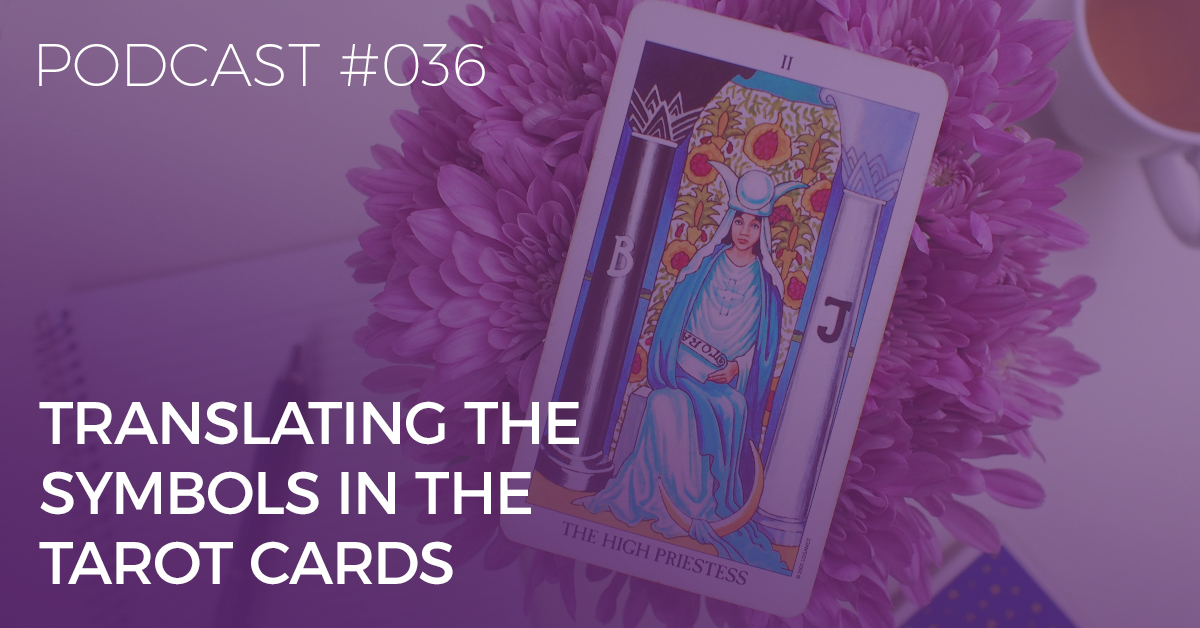
>> DOWNLOAD THE FREE PDF: TRANSLATING THE SYMBOLS IN THE TAROT CARDS
The Tarot cards are rich in symbolism and the amount of information and insight stored within those symbols is immense. But knowing how to translate the symbols into something meaningful can be challenging.
How on earth are you meant to learn the different philosophies and spiritual structures that go into the Tarot cards? And how are you supposed to know exactly what every symbol means?
In this podcast, I'll show you how to translate the symbols in the Tarot cards with effortless ease!
You'll learn…
- The difference between traditional symbolism and personal symbolism
- How the symbols in the Tarot cards can jump-start your intuition
- Six actionable tips that you can use in your Tarot practice to tap into the symbolism in the Tarot cards.
Additional Resources
- Master the Tarot Card Meanings online training program
 Podcast Transcript
Podcast Transcript
Brigit: You are listening to the Biddy Tarot Podcast, and this is Episode 36: Translating the Symbols in the Tarot Cards.
Introduction
Welcome to the Biddy Tarot podcast, where you will learn how to connect more deeply with your intuition and live an empowered and enlightened life with the Tarot cards as your guide.
Listen as Brigit and her guests share their very best tips and strategies to help you read Tarot with confidence. And now, here is your host Brigit Esselmont.
Brigit: Hello and welcome back to the Biddy Tarot Podcast, I am thrilled as always to have you here and sharing our love for Tarot. So, we all know that the Tarot cards are rich in symbolism and there's an immense amount of information and insight stored within those symbols. But knowing how to translate the symbols into something meaningful can be super challenging. How on earth are you meant to learn all of the different philosophies and spiritual structures that all go into the Tarot cards? And how are you supposed to know exactly what every symbol means when you are looking at these Tarot cards?
Well, in today's podcast I want to make it really easy for you to translate the symbols in the Tarot cards. I'm going to show you the difference between collective knowledge about the symbols and your own personal connection to the symbols. Plus I am going to give you six actionable tips that you can use in your Tarot practice to make the most out of the symbols contained in the Tarot cards.
But before we get into all of that juicy goodness, I want to say a huge thank you to everyone who sent in a review and shared their feedback and their comments. Remember if you love this podcast and you want to support it, please head on over to iTunes and leave an honest review, five-stars is always a good thing, and that would absolutely appreciated. I just want to share with you two five-star reviews that have been left recently as a way of saying thank you and acknowledging this feedback.
So, Mr. Steven R. from Australia says:
“Each episode is being constructed with a clean structure for the title subject. There isn't any meandering or weak points, but an almost lesson-like delivery. The presenter doesn't have a dreamy, soft and dare I say sickly, baby talk voice.” I'm being a bit cheeky there, “instead Brigit has an Australian accent with a radio presenter styled voice. I believe that this podcast is male friendly, by that I reflect above Brigit's style is very level headed which shouldn't offend anybody, nor bore anyone at the same time.”
Well, thank you so much Mr. Steven R., I'm glad you enjoy my radio presenter voice, that's very sweet. Thank you.
And I've also got some feedback here from D. Marcan from the U.S. and this person says:
“I'm super excited to have found these podcasts. I've already listened to at least six podcasts this weekend. Brigit is full of amazing insight into the Tarot. Her podcast are entertaining and educational. I highly recommend them.”
Thank you so much, I really, really do appreciate it and remember if you want to leave a review and haven't done so already, just pop on over to iTunes, and again you can always click those five stars, and just leave your honest and constructive feedback. That would be absolutely wonderful.
All right, let's get into Tarot and symbolism. Now as I said at the start, Tarot is so rich in symbolism. You look at any card and you can see so many different things in those cards and it often has ties back to particular symbolic like associations, not just a pretty picture. In fact with the Rider Waite, is just a sample of where some of the symbolism originates from. So you've got symbols from Kabbalah, Christianity, Judaism, Paganism and also the golden Dawn and particular around the Astrological attributions. And then you've also got to remember you've got numerology and other astrological associations that you can also throw into the mix.
And that's just the Rider Waite; if you pick up another kind of deck you're going to get a whole different raft of symbols. Whether it's the artist that's creating that Tarot deck, who is linked into a certain symbolic philosophy, or that Tarot deck might be organized or created around a specific philosophy. So for example, the Osho Zen is very much about Zen symbolism and so on.
So, on one hand it can be really exciting because your like, yes there's so much symbolism here and we know that the symbolism just kind of unlocks so much meaning and insight. In fact, you can just take one small symbol or picture and that will elicit so much knowledge, experience, feelings emotions, you name it that really gives a lot of meaning to that particular symbol. But on the other hand it can be incredibly overwhelming, particularly if you're just at the early stages of learning how to read Tarot and you're thinking, goodness me I've got to learn 78 Tarot card meanings and now you want me to learn about symbols and you want to have me understand exactly where every symbol comes from and the whole story behind every symbol? Whew. No wonder a few people end up quitting Tarot all together, which is clearly not what I want to have happen.
Wish You Had A Tarot Card Meaning Cheat Sheet?
Get Your FREE Tarot Card
Meanings Reference Guide
And Avoid Getting Stuck When Trying To Remember The Card Meanings

I'm going to give you some of my best tips on how you can translate the symbols in the Tarot without getting your knickers in a knot. Because really there is just so much rich information as you really dive deep into the symbols, but what's really important for me is that you don't get overwhelmed. I really want to make this fun and easy and enjoyable for you.
But before we get into these tips that I have to share with you, I wanted to just touch on how we understand the origins of symbolism and how do we find out what does a particular symbol mean? When we think about symbolism, and the meanings behind the symbols, it really sort of falls into two buckets, one we've got collective wisdom about what the symbols mean and on the other hand we have individual personal wisdom. So when we think about collective wisdom, collective wisdom really is the commonly held associations for the symbols and those are associations have been created over centuries, generations. It's something that's been sort of passed down, whether it's through a sort of religious belief system, whether it's through other spiritual systems, you name it, it's kind of like the traditional meaning behind the symbols.
For example, say a circle, you look at the circle and one of the commonly held meanings for the circle is this idea of cycles and eternal life, I suppose because if you think about a circle it keeps going round and round and round, around, there’s' no sort of corners to it, there's no stopping it just keeps going round and round. That would be the sort of the collective wisdom around the symbols.
But there is also the personal wisdom or individual wisdom around symbols and these are kind of like the individual associations that are formed through our personal experiences. And you know, depending on how you see life it might be your personal experiences in this lifetime or it might be your collective experiences over many lifetimes. I'll leave that one up to you to decide, but let's at least think of it in terms of this lifetime and the different kinds of experiences that you might have had.
So let's say where thinking about that circle again and you might've had a very different experience with a circle. Oh goodness, I’m pulling this one out of the air but let's say you were very interested in crop circles, for example and maybe for you the circle has a lot of meaning around alien life and that might actually be quite meaningful for you. So I maybe it's not one of the best examples but I wanted to give that to you to show you that there is a difference between the collective meanings around the symbols and the personal meanings.
You might be wondering, ok that's great but which one’s the correct one, I want to make sure I’m right, I'm correct. Here's the thing, ask different people your going to get different answers. Some people will say to you must learn the traditional meanings of the symbols if you deviate from those symbols then you're faking it, you don’t know what you’re talking about because it's the collective wisdom that's the most important thing. And that’s fine if that the way you see things then ok. Taking that a little bit further, someone might end up telling you that you’re wrong because think of say the black cat in the queen of wands, you might have these personal associations with a black cat as kind of like the dark side and you might see that cat as a sign that the dark side of the queen of wands but someone tells you no, no you’re all wrong because actually in the Rider Waite deck that cat is just the artist’s cat, it's got nothing to do with the dark side. But here's the thing, does that really matter? If you have this strong connection to the black cat and you think, yeah that’s the dark side; yep I’m really feeing it. Isn’t that more powerful than knowing well, the sort of I guess the collective wisdom is that the cat belong to the artist who created the deck so Pamela Connor Smith and you know it's got no meaning apart from the fact that it's just her cat and she wanted to get that in to the Tarot deck somehow.
So, that's the thing, I think as you’re looking at do you follow the collective wisdom or your personal wisdom around the symbols, I really feel that it's a balance of both. It's good to get that foundational understanding of what the traditional meanings of the symbols are in the cards, but it's also really important to form those personal connections to the symbols. Think about it in terms of the Tarot cards meanings as well, this is what I also teach in that we've got to have that base level understand of the sort of traditional meanings behind the cards, but we also need that personal and intuitive connection with the cards. So keep that in mind.
All right, so what I want to do now is share with you six actionable tips that you can use in your Tarot practice to make the most out of the symbols in the Tarot cards. Remember my intention here is to have you having fun with your Tarot cards and not feeling overwhelmed or pressured to know certain things or suddenly become a master in everything.
Let's get started, so number one, start with what you know. And the reason I'm putting this as number one is because, again, I want you to come from a place of confidence. So for example, if you've already got an interest in Christian symbolism, then have a think about what do I know about Christian symbolism and how am I seeing that portrayed in the Tarot cards? Maybe you've got a really good understanding of Kabbalah in which case you might start to look through your Tarot deck and look for the symbols associated with Kabbalah. Doing this will just give you that level of confidence, like yeah, I’ve got this, I already know some stuff and I can see it in my Tarot cards. Don't feel like you need to learn all of these new things and become a master of everything in order to understand the Tarot cards and the symbolism.
Ok, so number two is find common symbols and research their meanings. So, if you look through the Tarot deck you're going to start to notice that there are a few common images or symbols across the cards. For example there are a lot of castles in the Tarot. There are lots of clouds, there are lots of different landscapes, and so on. So, it can be really helpful to find these common symbols and then start to find out what’s kind of that collective wisdom around these symbols. What does a castle mean traditionally? So, I'm trying to help make this like super easy for you so, I've created a list of common symbols and their general meanings and you can download that PDF at BiddyTarot.com/36 and you can print that off and keep that in a handy place as you're looking at your Tarot cards. Of course, just remember that this is a starting place, it's not a definitive guide to symbolism in the Tarot but it's certainly a good starting place. So, have a look through your Tarot deck, look for some of those common symbols and start to research their meanings, so you've got that base level understanding.
All right, number three is: explore your personal connection with the symbols and this is kind of like the fun bit where you can get your intuition really going and you can start to connect more with your subconscious and understand what do these symbols mean for you personally. So for example, let's say the castle, we know again that the traditional meaning for the castle is a place that is quite safe, because there the walls around the castle are very big and quite sturdy, so traditionally the castle does represent a safe and sturdy structure in some ways. But you might look at that castle and look at those walls and think: “Oh my goodness, I love freedom.” So being surrounded by walls, that's not going to make me feel very free so it might actually have negative connotations for you. It's good to connect to what does a castle really mean for me, how do I see the castle? And maybe how does that differ to the collective wisdom around what a castle means.
Another example is a lion, you know we look at the strength card and we see the lion there. Now you might have been on African safari one day and have met a lion and were like you know scared down to your bones and you don’t ever want to see a lion ever again because it growled at you and it made you feel very worried about your safety. On the other hand, you know if you're someone like me, I had this little toy lion, a soft toy, and lion would help me get better if I ever felt unwell so for me lion is like a protector in some way, so I have a very different association with the lion.
So, it's so important that you connect not only with what does everyone else think the symbols mean but what do you think that symbol means, what significance does it have in your life? Because when you’re doing a Tarot reading, that cards going to show up for you, your attention's going to be drawn to that symbol and it's for a reason. It's like its your subconscious or your intuition saying, hey, look at this symbol, this has meaning just for you, you know you don’t have to worry about what the books says about that particular symbol, it's what does it mean for you.
Ok, let's move on now to number four, and this is actually more of an exercise that you can do that will deepen your understanding of the symbols in the cards, and that is compare the symbols across the Tarot cards. So for example, we were talking about castles before, it's a very common symbol that you'll see in the Tarot so go through your Tarot deck and pull out all of the cards that have castles in them, then simply just look at the imagery across each of those cards and think about does the meaning of the castle change as you look at it across different cards? Are you standing inside of the castle walls, or are standing on the outside of those castle walls? And how does that feel, do you feel included or excluded? Do you feel safe or unsafe? Have a look at what is happening around the castle, I'm thinking of say the Four of Wands, and yes they're outside the castle but it's a celebration it's fun it's happy, you know how does that sort of sit with you? If I think of the Tower, you could say that's kind of like a castle structure, but in this case it's all coming tumbling down. So are castles really as sturdy as you think that they might be? So have a look at these symbols across the various cards and start to see that symbols can take on different meanings depending on the meaning depending on the context depending and what's happening around those symbols you’ll start to see this beautiful flow and sort of dynamic energy that goes around the symbols in the Tarot cards.
All right number five is read widely. So if you are feeling pretty good at this stage, you know you've explored what you already know, you've look at some common symbols and found some common meanings for those symbols, you’ve explored your own personal connection with they symbols and you've started to compare the symbols across the cards, you might be ready to say: “Ok, you know what I know nothing about Kabbalah but I want to find out because I want to have that extra layer of understanding when I see symbols associated with Kabbalah in the Tarot.” So go and start reading books about the Kabbalah and discover what those symbols might mean.
You know you could also read about mythology, I've just recently finished the book with Joseph Campbell and it's the Power of Myth and you know it is a difficult read but it was fascinating because there's so much rich symbolism in there and I couldn't help but keep connecting it with the Tarot. If you read other books around mythology, even I'm reading books now on like the Indian goddesses and just seeing again that connection back to the Tarot and making those different associations. It just deepens your understanding of the symbolism in the cards.
And finally number six is creating a library of symbols. As you’re doing all of this amazing research and exploring what the symbols mean for you, then keep a notebook of the very symbols that you’re discovering and you know what they mean for you. So you might maybe, here comes my ordered brain, you might set up your book in the alphabet and under “A” you might list Angel or Ark, under “C” you’re going the have castle or cloud or circle and each time you discover something new about those symbols, make sure you jot it down and keep a note. Because that is going to give you so much rich information that you can continue to draw upon. And the beauty of it is that your not simply relying on again on what someone else tells you a symbol means, you are starting to grow up your personal experience around those symbols.
So there you have it, those are my six tips to help you translate the symbols in the Tarot cards. I hope by now that you're feeling excited about understanding the symbols in the Tarot cards and you’ve kind of released any of those feelings that might of lead to overwhelm. Because if you really break this stuff down and to you take it easily and you take it as it comes and remember you don't have to be right, you don’t have to have the right way, is what I mean and you don't have to be like a PHD of symbolism in order to benefit from the symbols in the Tarot cards. It's really just about you creating a personal connection with the symbols in the cards and acknowledging the power and the impact that they have in your Tarot readings. It's truly amazing and it just gives you so much insight when you are reading the Tarot cards.
Thank you so much for listening today I hope that I've helped you build your confidence with reading the Tarot cards intuitively and of course if you want to take this deeper you’re going to love the Biddy Tarot Community, where you can ask questions about the symbols in the cards, you can compare notes with your Tarot friends about what they think a castle might mean or the different insights that they’ve had with the symbols in the Tarot card. We've got private discussion forums, monthly Tarot training webinars, the Tarot101 course to help you read Tarot intuitively and quickly, and so much more. I would so love to see you inside of the community, to find out more head on over BiddyTarot.com/community. And remember for today if you want to catch the show notes and get the PDF download of some of the common symbols in the Tarot, head on over to BiddyTarot.com/36. And you can download it there.
 Thanks again for listening and I can't wait to connect with you next time and until then happy Taroting.
Thanks again for listening and I can't wait to connect with you next time and until then happy Taroting.

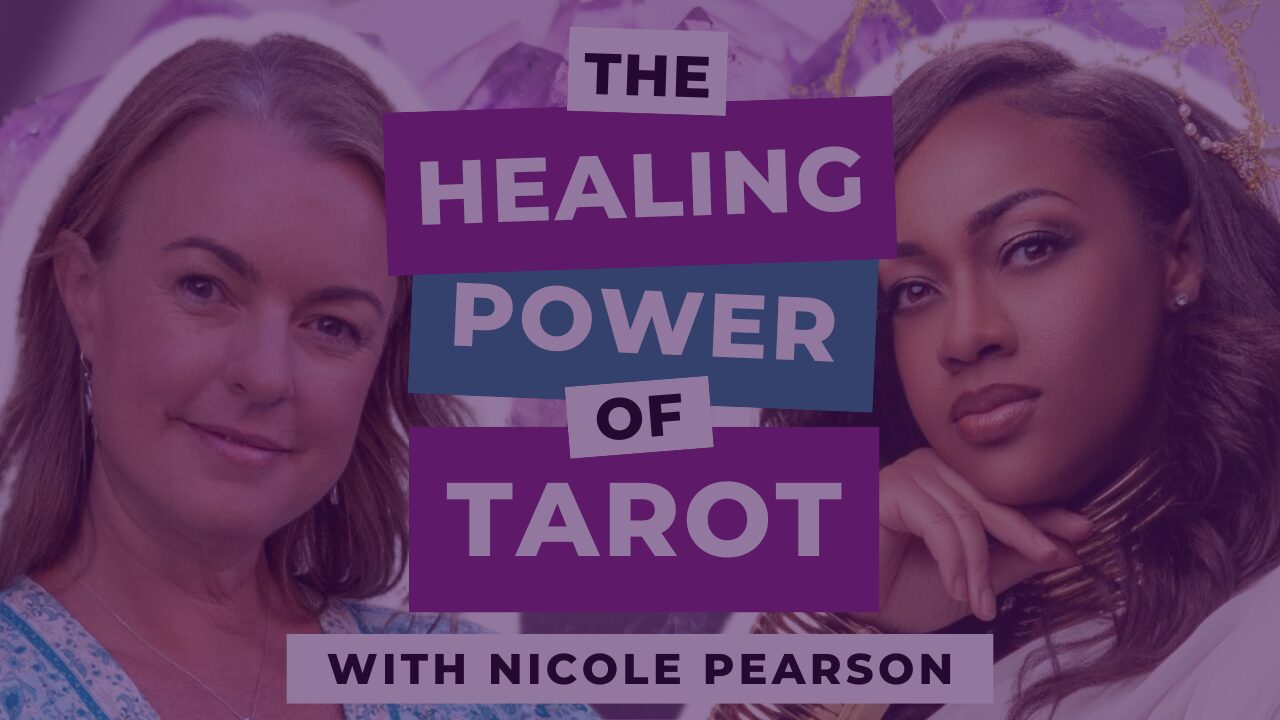
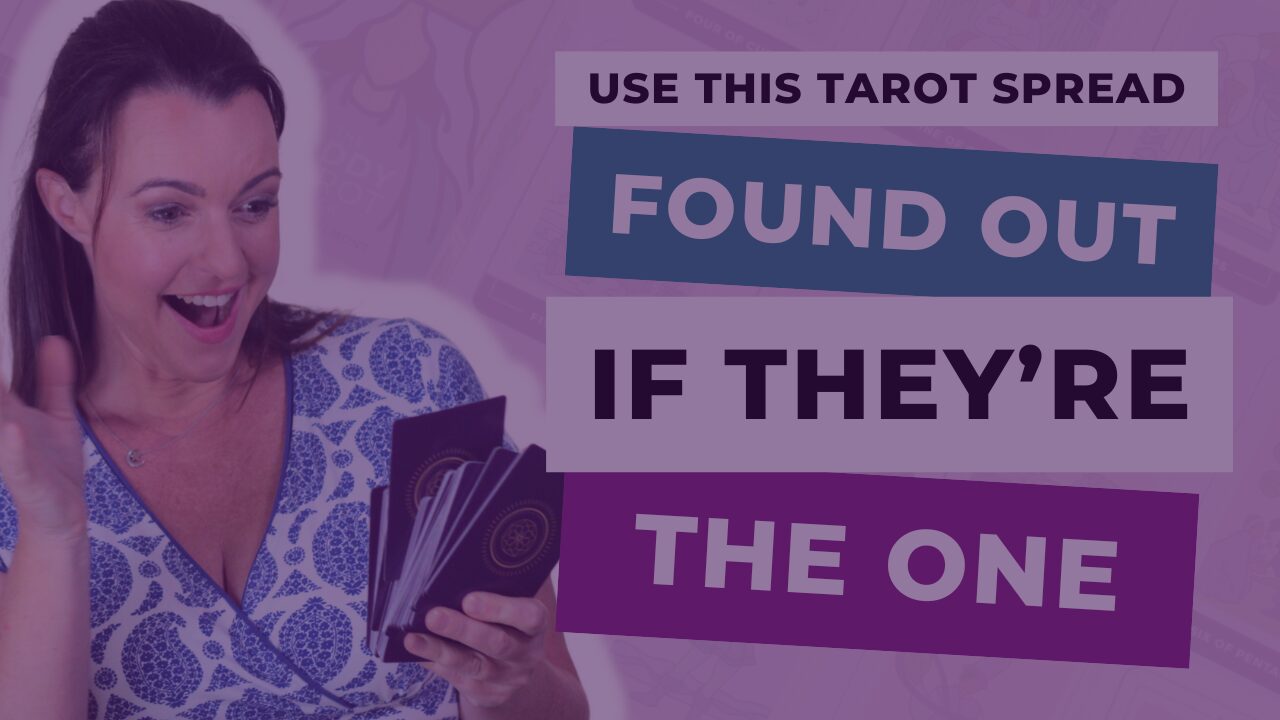

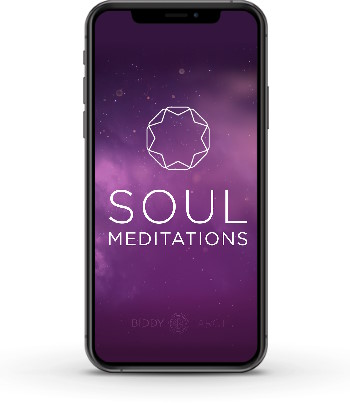 Harness the wisdom of the Major Arcana with 22 guided meditations. Here’s what you’ll get:
Harness the wisdom of the Major Arcana with 22 guided meditations. Here’s what you’ll get: Start doing deep, accurate readings TODAY with this step-by-step accelerated program for beginners.
Start doing deep, accurate readings TODAY with this step-by-step accelerated program for beginners. Here’s what you’ll find inside for every card in the deck:
Here’s what you’ll find inside for every card in the deck: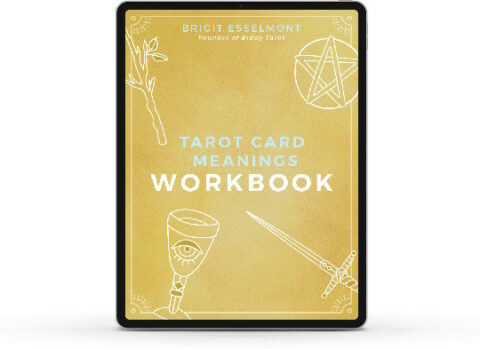 Create a deeply intuitive and personal connection to the Tarot cards with your very own Tarot Card Meanings Workbook. Here’s what you’ll find inside the workbook:
Create a deeply intuitive and personal connection to the Tarot cards with your very own Tarot Card Meanings Workbook. Here’s what you’ll find inside the workbook: